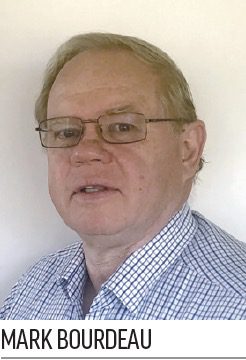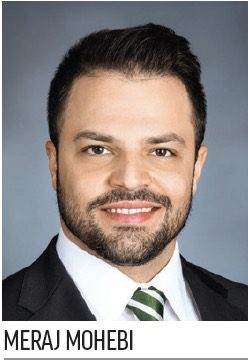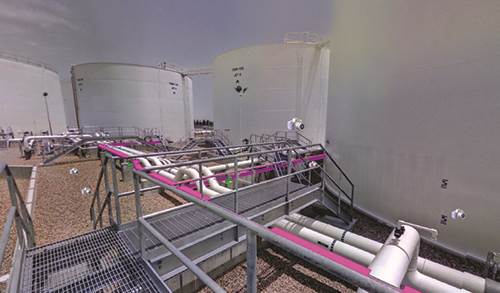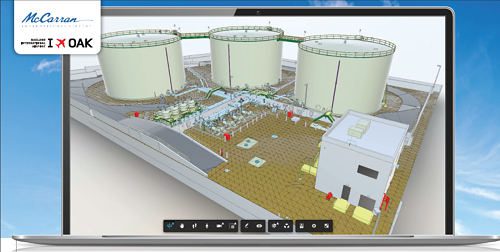Fuel storage facilities at McCarran International Airport (LAS) in Las Vegas and California’s Oakland International Airport (OAK) are using a new cloud-based asset management system to overcome obstacles that plague the entire industry—problems such as a lack of timely, accurate information and multiple software programs that don’t speak to each other.
Fuel storage facilities at McCarran International Airport (LAS) in Las Vegas and California’s Oakland International Airport (OAK) are using a new cloud-based asset management system to overcome obstacles that plague the entire industry—problems such as a lack of timely, accurate information and multiple software programs that don’t speak to each other. After two years of pilot testing the platform, personnel from facilities at both airports report ready access to real-time operating information and better visibility of asset performance. Longer-term, they foresee the new management system facilitating a more proactive approach to maintenance that will help prevent premature equipment failure and decrease overall repair expenses.
A subsidiary of Argus Consulting Inc. developed SAIM™, the Smart Asset Integrity Management platform, to put all of a fuel farm’s stakeholders on the same page by providing them with a single source of current and historic operating data. SAIM personnel explain that real-time data collection to a cloud-based system gives all stakeholders—the airport, facility owners/users and key technical staff—information to make better decisions about engineering, inspection, operation and maintenance.
|
facts&figures Project: Asset Management for Fueling Facilities Locations: McCarran Int’l Airport in Las Vegas; Oakland (CA) Int’l Airport Timeline: In development since 2017; pilot programs launched in 2019 System Deployed: SAIM, Smart Asset Integrity Management Developed by: SAIM LLC, a subsidiary of Argus Consulting Inc. Key Benefits: Single, centralized source for engineering, inspection, operations & maintenance data; 24/7 access by authorized users to facilitate real-time decision making Assists With: Scheduling; budgeting & resource planning; turnover challenges; achieving maintenance milestones; centralizing documentation; tracking & trending of data |
Nearly five years in development, the platform recently completed pilot testing at LAS and OAK and is now ready to expand to airports across the United States and beyond.
Addressing Specific Needs
The SAIM platform includes customizable modules to address each facility’s specific needs. The foundational capabilities—maintenance, monitoring and as-built—were developed to help fuel facilities organize their information, streamline workflow and provide critical data to onsite and remote stakeholders that are responsible for maintaining continuity of service. Although these are important objectives for everyday operations, they become even more crucial when something in the facility malfunctions. That’s when personnel rely on a management system that helps them access information, communicate clearly and act quickly. SAIM is also designed to help prevent malfunctions and failures from occurring in the first place.
Here’s how its three main components work.
Maintenance – The Tank Farm Manager Module takes the paper out of traditional inspection and maintenance processes by capturing electronic work orders, inspection logs and maintenance records in one central location. Daily, weekly and annual inspection and maintenance tasks are clearly defined for operating staff, and progress can be monitored and communicated using dashboards designed for various stakeholders.
This aspect has been a game-changer for Nolan Getty, fuel category manager for Southwest Airlines and chair of LASfuel Corp. at LAS and Oakland Fueling Facilities Corp. at OAK. “We’re in 2021, and across the industry we’re still pretty much paper-based on any type of inspections or maintenance,” Getty observes. “Instead of binders upon binders of paperwork, with SAIM, our operators can log everything into a digital system. It gives them a tool they can count on to keep track of inspections and maintenance, and it brings that piece of the facility up to the 21st century.”
The SAIM team goes on site to help operators digitize important facility documentation, which is then stored in an online document management archive so it’s available to all authorized stakeholders for the life of the facility. Files typically include maintenance records, equipment manuals, training information, record drawings, inspection documentation, photos and compliance documents. Moving forward, new inspection and maintenance records are captured using handheld devices that sync with the platform and tie the data to specific assets, so it’s streamlined for operators and easier to recover for planning and compliance purposes.
Monitoring – The Real-Time Signals Module captures live feeds coming in from critical facility equipment and assets. Visual dashboards display trends, signal alerts and provide on- and off-site staff with early indications of issues to avoid costly equipment downtime and/or failure.
 The dashboard allows Mark Bourdeau, manager of global fuel procurement and operations for Delta Air Lines, to keep tabs on one of his biggest recurring costs at LAS and OAK: energy consumed by the high-demand electric motors that drive the facilities’ fuel pumps. The SAIM system provides real-time data about pump operation that allows Bourdeau to analyze costs, including run time and how the pumps are sequenced, from his office in Atlanta. “Using that data, we can streamline the operation where we have choices about things like time of day,” he explains. “As a result, I might move certain parts of the operation into a different time of day when the energy cost is either lower or more available.”
The dashboard allows Mark Bourdeau, manager of global fuel procurement and operations for Delta Air Lines, to keep tabs on one of his biggest recurring costs at LAS and OAK: energy consumed by the high-demand electric motors that drive the facilities’ fuel pumps. The SAIM system provides real-time data about pump operation that allows Bourdeau to analyze costs, including run time and how the pumps are sequenced, from his office in Atlanta. “Using that data, we can streamline the operation where we have choices about things like time of day,” he explains. “As a result, I might move certain parts of the operation into a different time of day when the energy cost is either lower or more available.”
The system is also valuable when something goes wrong— if, for example, a pump vibration sensor indicates an alignment issue at 3 a.m. No matter where they are, everyone identified for that scale of notification receives real-time data to facilitate an immediate response. Of equal importance, operating data from monitored assets is captured to establish key performance metrics that ultimately support planning and budgeting for capital and operating expenditures.

As-builts – The Photos and Measurements Module and the 3-D CAD Model modules work together to create a digital online replica of the tank farm or other physical assets.
Meraj Mohebi, Ph.D. and chief technical officer at SAIM LLC, explains that his team engineered the entire backbone of the platform around 3-D representations produced from LIDAR scans, photogrammetry and 3-D as-built models of existing assets. The digital twins are particularly useful for off-site owners, consortium members, engineers and operational management. Mohebi notes that the 3-D models are also incredibly valuable for infrastructure improvement and development projects, because they can be used for accurate measurements and calculations for engineering and estimations.
Having a 3-D digital proxy of the fuel farm at LAS came in particularly handy when the design process of the recirculation system and oil water separator was impacted by COVID-19 travel restrictions. Using SAIM’s as-built module allowed engineers to avoid traditional survey and site visits.
Simplicity & Accessibility
As a longtime partner to airports, airlines and fuel facility operators, Argus Consulting saw gaps that were increasing risk and creating budget headaches. “An airport’s fuel handling system is incredibly valuable in terms of investment and operational importance, but the innovation of utilizing data and available IT advancements for fuel has been missing,” says Mohebi. So the company developed SAIM to give owners and operators a clear view of how their fuel systems are performing, and to facilitate preventive maintenance and help extend the life and value of infrastructure.
“In the last 25 years in fuel system design, engineering and maintenance support, we have watched the collaborative efforts between the operators, engineers and owners of the facility strain as each site and the companies involved work with their own communications and document management structure,” Mohebi says. When each entity uses a different type of software or a variety of internal company servers, it is difficult to share information or collaborate on critical or timely decisions.
To remedy such issues, SAIM LLC developed a central, common-ground system that integrates technologies and provides visual dashboards so stakeholders can see what is needed to keep fuel flowing and systems compliant.
Having a centralized repository has been invaluable for Bourdeau. “In a world in which people are constantly changing, you need a constant. And that constant is good information,” he explains. “With SAIM, no matter who, individually or as a group, is making a decision, the data is very clear. And if the data is very clear, that’s 90% of the decision.”
To be truly valuable, data has to be readily available to everyone who needs it. That’s why SAIM is a cloud-based platform, explains Mohebi. In fact, the development team’s motto was “simplicity and accessibility 24/7 from anywhere, anytime.” System engineers wanted to spare fuel farm operators, airlines and airports from having to install new software or use special equipment. Instead, authorized users can access the platform through a computer, phone or tablet connected to the internet. “In our view, new software is a new problem,” says Mohebi. “You have to install it, and someone has to train you. With SAIM, we’ve worked to make it very simple.”
Although off-the-shelf asset management systems already existed, they were not flexible enough for the unique needs Argus had identified, he notes. SAIM LLC consequently formed a technical steering committee with consortium members from several large fueling facilities to provide feedback and insight about its alternative.
“This is not an out-of-the-box cookie-cutter product,” Mohebi emphasizes. “ It was thoughtfully engineered with the needs of the aviation fuel industry in mind.”
For example, the SAIM Tank Farm Manager Module includes template maintenance and inspection tasks that are specific to aviation fueling facilities. Real-time signals, dashboards and analytics show post-processed quantities that are important to fuel facility operators and engineers; and the system’s predictive fuel inventory algorithms are customized for the aviation fuel supply chain.
Return on Investment
 Dan Liss, director of asset management services for Argus, served as the “boots on the ground” when the new platform was implemented at LAS and OAK.
Dan Liss, director of asset management services for Argus, served as the “boots on the ground” when the new platform was implemented at LAS and OAK.
Before joining Argus Consulting six years ago, Liss worked in fuel farm operations for 15 years. “I’ve seen the big challenges most operators face,” he comments. “I’ve lived the nightmares, having received calls in the middle of the night when systems weren’t functioning properly—pumps failing, generators failing. We needed better tools to get our arms around the challenges and operate more efficiently.”
Without a doubt, Liss considers improving infrastructure reliability and sustaining fuel flow to aircraft as SAIM’s biggest benefits. He also considers its maintenance tracking capabilities critical for keeping complex storage and dispensing systems up and running.
Using the trend data SAIM provides, facility operators can often predict rather than react to mechanical problems. “They can make maintenance-driven decisions to prevent early failures,” Liss explains. “Plus, the system tells you what workload you have. It prompts you with what maintenance tasks need to be done and when they are due, so managers know what resources will be needed and operators—even if new on the job—have a clear understanding of the inspections and tasks at hand.”
Personnel at LAS saw a clear return on investment for the new management platform when airlines asked them to engineer a transfer line in an area already densely populated with pipes and tanks. “The laser scan and 3-D model of the facility allowed the engineering team to develop the design without visiting the facility or conducting additional surveying,” Liss reports. “It also expedited the permitting process with authorities [by almost two months].”
Moreover, SAIM provides visibility and transparency to help stakeholders work together during stressful times. For instance, if a fuel supply issue occurs, the platform uses real-time fuel inventory data and historical fuel consumption data to predict how long the facility can continue to operate before another delivery of fuel arrives.
Such information recently proved invaluable when the facility at LAS experienced quality issues that disrupted supply. Even though Getty is based in Dallas and his engineering team was based in Kansas City, both knew precisely how much fuel was available and were able to collaborate with the local operators to rapidly communicate and implement measures to avoid any flight delays. “With SAIM, we can all be in the same software looking at the same information in order to make our decisions to mitigate any issue,” Getty explains.
When talking with a facility operator or general manager about a specific piece of equipment, he uses SAIM to look at the component in question—without incurring travel costs or delaying a decision about corrective action.
Liss cites another example, when a defective valve was identified at a facility. “We conducted a virtual walkthrough with a contractor the day the issue was identified, and they were able to understand the issue, provide a proposal and procure the equipment without scheduling a visit to the facility, which significantly reduced their price and time to execute the work,” he reports. “With all these examples, we had a clear return on investment for the airlines and the operator. Add up the many ways these capabilities are used from week to week, and it’s easy to see how valuable this tool can be.”
Bourdeau adds that the operating and performance data collected from SAIM makes it easier to gain consensus for capital investments among the large group of stakeholders involved in budget decisions for large projects.

Continuous Improvement
As stakeholders at LAS and OAK became more familiar with the new asset management system, they provided honest, ongoing feedback that was invaluable to the development of the SAIM platform.
“The team at Argus does a really great job of taking the feedback from several different parties—and sometimes different feedback—putting it into the tool, and then deploying it out and into operations,” says Getty.
The SAIM platform is continuously collecting real-time signals from critical assets at the facility and related performance data. “Right now many facilities don’t have the tools in place to operate in a proactive mode,” Mohebi explains. “As more facilities begin using SAIM, anomaly detection and predictive analytics will continue to increase service life, lower operating cost and inform decision making. Additionally, owners can use the information across locations to create standardized metrics, measurable key performance indicators and benchmarking goals.”
Getty and Boudreau both look forward to additional facilities going online with SAIM and the benchmarking information that will be provided. “We consider Argus to be an industry partner,” Bourdeau says. “They’re not just a contractor to us. With SAIM, they saw the value it would provide, not just to us as customers, but also to their portion of the industry. The data that I’m going to use to drive accountability and performance metrics is beneficial to them as well.”
That data will help facilities answer questions such as:
- Are we spending our limited budget in the right places to support continuity of service?
- Does my staff have a clear understanding of what’s expected of them and the tools to respond accordingly?
- Is critical maintenance occurring to minimize risk, maximize service life and maintain compliance?
- Are we operating efficiently?
Such questions help develop best practices, says Boudreau. “Sometimes we don’t know what those best practices are until we see data to reveal them,” he remarks. “But they’re essential if you’re going to drive an overall improvement to everybody across the board.”
“Everybody” is a key word for Liss. For him, all of SAIM’s high-tech bells and whistles boil down to one primary goal: getting fuel facility owners, operators and engineers on the same page to ensure total quality assurance in asset management.



